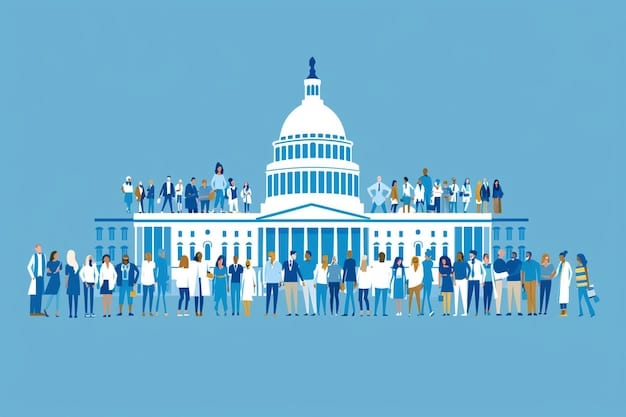The Future of US Healthcare Reform: Political Proposals in 2025

The Future of US Healthcare Reform: A Political Analysis of Competing Proposals in 2025 examines the potential healthcare policy changes in the United States, analyzing the political feasibility and implications of different reform proposals amidst a divided political landscape.
The future of healthcare in the United States remains a highly debated and constantly evolving topic. The Future of US Healthcare Reform: A Political Analysis of Competing Proposals in 2025 will likely be shaped by the ongoing political battles between various stakeholders, each with their vision for a better healthcare system.
Understanding the Current US Healthcare Landscape
The current healthcare landscape in the United States is complex, with a mix of public and private insurance options. Understanding this complexity is crucial for evaluating the potential impacts of any future healthcare reform.
Several key pieces of legislation and market forces have shaped the current system, leading to both advancements and persistent challenges.
Key Legislation and Market Forces
The Affordable Care Act (ACA), also known as Obamacare, represents a significant intervention in the healthcare market, aiming to expand coverage and regulate insurance practices. However, other factors also shape the sector.
- Employer-sponsored insurance: The most common form of health coverage for working Americans.
- Medicare: A federal program providing health coverage for individuals aged 65 and older, as well as some younger people with disabilities.
- Medicaid: A joint federal and state program providing health coverage to low-income individuals and families.
These components contribute to the dynamics in the current US healthcare system.
Challenges and Shortcomings
Despite the presence of these various systems and programs, the US healthcare system faces numerous challenges.
- High costs: The United States spends significantly more on healthcare per capita than other developed nations.
- Access disparities: Coverage and access to care vary widely based on factors such as income, location, and insurance status.
- Complexity and administrative burden: Navigating the system can be challenging for patients and providers alike.
These challenges underscore the need for continued reform efforts to improve healthcare for all Americans.
In conclusion, the current US healthcare landscape is characterized by a complex interplay of public and private entities, with significant challenges related to cost, access, and administrative efficiency. Understanding this landscape is essential for analyzing future reform proposals.
Competing Political Proposals for Healthcare Reform
As the 2025 approaches, several competing political proposals for healthcare reform are gaining traction. These proposals reflect different ideological perspectives and priorities regarding healthcare policy.
Understanding the core tenets of these proposals is crucial for evaluating their potential impacts on the healthcare system and the American population.

The “Medicare for All” Proposal
Advocated by progressive lawmakers, the “Medicare for All” proposal seeks to establish a single-payer healthcare system financed by taxes, offering comprehensive benefits to all US residents.
This approach aims to eliminate private insurance and ensure universal coverage, reduce administrative costs, and control healthcare spending through government negotiation of prices.
The “Affordable Care Act” Enhancements
Other proposals focus on building upon the foundations of the Affordable Care Act, seeking to expand coverage and affordability through measures such as increased subsidies, the creation of a public option, and strengthened consumer protections.
These enhancements aim to address gaps in coverage and affordability while preserving the role of private insurance markets.
Market-Based Reforms
Conservative lawmakers often propose market-based reforms that emphasize consumer choice, competition among providers, and deregulation of insurance markets.
These proposals may include measures such as expanding health savings accounts (HSAs), promoting high-deductible health plans, and allowing the sale of insurance across state lines.
In conclusion, the political landscape for healthcare reform is characterized by a diversity of proposals reflecting different ideological perspectives and priorities, each with its implications for the future of healthcare in the United States.
Political Feasibility and Challenges in 2025
The political feasibility of enacting comprehensive healthcare reform in 2025 will depend on the partisan composition of Congress and the White House, as well as the level of public support for different approaches.
Navigating the complex political landscape will require strategic compromise and coalition-building among policymakers.
Partisan Divisions
Healthcare has become a highly polarized issue, with deep divisions between Democrats and Republicans regarding the role of government in healthcare.
- Negotiating bipartisan solutions will be challenging, particularly on issues such as the future of the ACA and the role of private insurance.
- Gridlock in Congress could impede efforts to address pressing healthcare challenges.
Stakeholder Interests
Various stakeholders, including insurance companies, pharmaceutical manufacturers, hospitals, and patient advocacy groups, will seek to influence the healthcare reform debate.
- Balancing the interests of these diverse stakeholders will require careful consideration of the potential impacts of proposed policies on different sectors of the healthcare system.
- Effective stakeholder engagement will be critical for building consensus and achieving meaningful reform.
Public Opinion
Public opinion on healthcare reform is divided, with varying levels of support for different approaches.
Public perceptions of the current healthcare system and attitudes toward government intervention will shape the political environment for reform.

In conclusion, the political feasibility of healthcare reform in 2025 will depend on a complex interplay of partisan dynamics, stakeholder interests, and public opinion, requiring strategic compromise and coalition-building to overcome political obstacles.
Potential Impacts of Different Reform Proposals
The potential impacts of different healthcare reform proposals on coverage, costs, quality, and innovation will vary depending on the specific policies enacted.
Evaluating these impacts will require careful analysis of the potential trade-offs and unintended consequences associated with each approach.
Coverage and Access
Proposals that expand coverage, such as “Medicare for All” or enhancements to the ACA, have the potential to reduce the number of uninsured Americans.
However, the impact on access to care will depend on factors such as provider participation, network adequacy, and the availability of resources in underserved areas.
Costs and Affordability
Different reform proposals will have varying impacts on healthcare costs and affordability for individuals, employers, and the government.
Some proposals may aim to control costs through government negotiation of prices, while others may rely on market-based mechanisms to promote competition and efficiency.
Quality and Innovation
Healthcare reform could affect the quality of care and the pace of innovation in the healthcare industry.
Some proposals may prioritize investments in preventive care and chronic disease management, while others may focus on promoting the adoption of new technologies and treatments.
In conclusion, the potential impacts of healthcare reform proposals on coverage, costs, quality, and innovation will depend on a complex interplay of policy choices and market dynamics, requiring careful consideration of the potential trade-offs and unintended consequences.
Economic and Social Implications
Healthcare reform has significant economic and social implications, affecting various sectors of the economy, individuals, and communities.
Understanding these implications is essential for assessing the broader societal impacts of healthcare policy changes.
Impact on the Economy
Healthcare spending accounts for a significant portion of the US economy, and changes to the healthcare system can have ripple effects on economic growth, employment, and government budgets.
Reform proposals may affect different sectors of the economy, such as insurance, pharmaceuticals, hospitals, and small businesses.
Impact on Social Equity
Healthcare reform can have profound impacts on social equity, affecting disparities in health outcomes and access to care based on factors such as income, race, and location.
Policies that expand coverage and address social determinants of health can promote greater equity and improve the health of vulnerable populations.
Workforce Implications
Changes to the healthcare system can affect the healthcare workforce, including doctors, nurses, and other healthcare professionals.
Reform proposals may need to address workforce shortages, training needs, and the distribution of healthcare providers across different regions and specialties.
In conclusion, healthcare reform has far-reaching economic and social implications, affecting various sectors of the economy, promoting social equity, and shaping the healthcare workforce, requiring careful consideration of the broader societal impacts of policy changes.
The Role of Technology and Innovation
Technology and innovation are poised to play an increasingly important role in shaping the future of healthcare reform.
Advancements in areas such as telemedicine, artificial intelligence, and data analytics have the potential to improve access, lower costs, and enhance the quality of care.
- Telemedicine: Telemedicine can expand access to care for patients in rural areas or those with limited mobility.
- Artificial intelligence: AI can be used to improve diagnostics, personalize treatment plans, and automate administrative tasks.
- Data analytics: Data analytics can help identify patterns and trends in healthcare data, leading to better decision-making and more effective interventions.
These technologies can potentially help transform the healthcare landscape and contribute to more patient-centered care.
To realize the full potential of technology and innovation, policymakers will need to address issues such as data privacy, cybersecurity, and regulatory barriers.
By harnessing the power of technology and innovation, healthcare reform can advance towards a more efficient, accessible, and patient-centered system.
| Key Aspect | Brief Description |
|---|---|
| 🩺 Coverage Expansion | Proposals aiming to insure more Americans, reducing the uninsured rate. |
| 💰 Cost Control | Measures to manage rising healthcare costs, including price negotiations. |
| ⚖️ Political Feasibility | Challenges in achieving bipartisan agreement on healthcare reforms. |
| 🤖 Technology Integration | Adoption of AI and telemedicine to improve healthcare delivery. |
Frequently Asked Questions
▼
The main proposals include Medicare for All, Affordable Care Act enhancements, and market-based reforms. Each aims to improve healthcare access and affordability through different methods.
▼
“Medicare for All” could lead to universal coverage and simplified administration. However, it may also face resistance due to changes in private insurance and potential cost concerns.
▼
The challenges include partisan divisions, stakeholder interests, and varying public opinions. Navigating these factors requires strategic compromise and coalition-building among involved policymakers.
▼
Technology offers solutions like telemedicine, AI, and data analytics to enhance accessibility, cut costs, and improve care. These innovations also require addressing privacy and regulatory hurdles.
▼
Each proposal impacts cost and affordability differently. Some may use price negotiations, while others rely on market mechanisms. The actual effect depends on policy details and market fluctuations.
Conclusion
The future of US healthcare reform in 2025 will be shaped by a complex interplay of political forces, competing proposals, and technological advancements. Addressing the challenges of coverage, cost, and quality will require strategic compromise and a commitment to innovation to build a more equitable and efficient healthcare system for all Americans.





